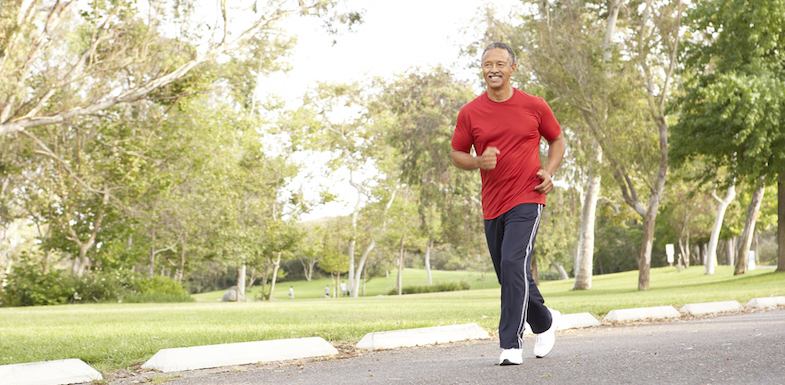Running with arthritis in the knee has long been a controversial subject. Traditionally, some people believed that running was so stressful on the knees that it could actually lead to arthritis in the first place. Fortunately, this idea has little to no merit; runners are generally no more susceptible to knee arthritis than anyone else. However, if you have just been diagnosed with knee arthritis, you probably have a lot of questions about what activities, including running, you can still safely perform. This article will discuss what you should know about running with knee arthritis, as well as what you can do to protect your knees while running.
Can I run with knee arthritis?
Arthritis is characterized by inflammation and pain, and it can affect virtually every joint. There are over 100 different kinds of arthritis. Osteoarthritis and rheumatoid arthritis are among the most common. Risk factors for arthritis include:
- Heredity
- Advanced age
- Obesity
- Smoking
- Joint stress or overuse (e.g. your job requires long-term, repetitive movements)
A knee arthritis diagnosis is tough for anyone, but if you previously enjoyed an active lifestyle that depended on having healthy knees, it can be especially devastating. Knee pain may tempt you to forget about doing any exercise at all, but a sedentary lifestyle will do you more harm than good.
The truth is, exercise can help arthritic joints feel better.
Running (safely) in particular may reduce your chances of needing surgery down the line. Better still, running is one of the cheapest forms of exercise out there; all you need is yourself, a good pair of running shoes, and someplace to run.
For most people, running with knee arthritis is safe. However, use common sense, talk to your doctor first, and pay attention to your body. If running worsens your pain, stop and take a break before you try again. Work with your doctor to create an exercise regimen that works for you.
Know too that any type of activity is great. It doesn’t need to be running. Walking briskly or swimming may be a better option for your body.
Does running make arthritis worse?
Even though the myth that running causes knee arthritis was debunked, other worries remain. For example, if you already have knee arthritis, will running make it worse?
The answer is complicated and likely depends on the patient and severity of the arthritis.
Some doctors say yes. They warn that running is bad for arthritis in the lower body, including the knees. This is especially true for people who have had knee surgery, and for people whose knees have already been damaged by arthritis. Running may increase arthritis pain and cause your knees to deteriorate faster.
However, a recent study found that running neither damages arthritic knees nor worsens arthritis pain. This is great news for runners, but the study does have flaws. For example, it neglected to record how and how much the participants ran.
More research needs to be done to truly determine what impact, if any, different running styles and speeds have on knee arthritis. But the newer study’s results suggest that a blanket ban on running with knee arthritis is not the best solution to preventing arthritis pain.
If you do have mild knee arthritis and genuinely want to run, talk to your doctor. If you have their permission, you may be able to continue running safely. You can also talk to them about other exercise options.
How to safely run with knee pain from arthritis
While exercise can improve any number of medical conditions, including arthritis, it’s important to exercise smartly and carefully. Before beginning any new running program, talk to your doctor, and then follow these general guidelines.

Consider your running routine
If you want to continue to run with knee arthritis, you can change your exercise routine to accommodate your condition. Alternatively, if you’ve never run before, begin slowly. Set an overall goal for yourself and then set small, attainable goals that you can achieve along the way as you gradually build your strength and endurance.
That said, if you have been running for a while and find that you truly don’t like it, don’t push it! Try different exercises until you find one that works for you. Exercise is an essential component of a healthy life, but forcing yourself to do an exercise you hate is setting yourself up for failure.
Even if you love to run, don’t let running be the only exercise you do.
Alternate running sessions with low-impact exercises, like swimming and weight-lifting. This will give you a well-rounded workout and strengthen your whole body. It will also give your knees a break from the motions and pressures of running.
When you do run, make sure you are doing so safely and properly. Proper running technique requires training your whole body to move in sync. With respect to your knees, always keep them aligned with your feet, and lift your knees high enough that you don’t shuffle as you run. If you find yourself getting so tired that you can’t maintain a proper running technique, it’s time to slow down.
You will also have to decide whether you want to run outside or on a treadmill. Running on a treadmill is easier on your joints, but running along a sand or dirt path is generally softer than a sidewalk. Try options near you to see which one works best for you.
Finally, if you’re having trouble motivating yourself to run, find a friend or group of friends to run with you. A 2017 study published in Nature Communications found that “exercise is socially contagious.” In other words, running with friends makes you more likely to stick to your exercise routine and push yourself harder than you would if you exercised alone.
No matter what, be kind to yourself.
It’s always hard to start a new exercise routine, especially when you’re already in pain. Your progress may not be a straight line. Some days, you may be able to run a mile with ease, while other days you may struggle to get around the block. This is normal, and you shouldn’t be discouraged by setbacks.
Do what you can when you can, and remember the goals that you are working towards: reducing your arthritis pain and living a healthier life.
Find proper equipment
In addition to proper running form, invest in high-quality running gear to ensure your knees get the support they need. Quality running shoes are perhaps the most important investment you can make. Shoes that are worn, don’t fit properly, or aren’t designed for running can damage your body, whether or not you have arthritis.
What is a “quality” running shoe? That can be tricky to determine.
The first step is to find a shoe that is the right size and fits comfortably. It may be tempting to stay home and buy your running shoes off the internet with the simple click of a button. With an investment as important as running shoes, though, it’s better to go to a store where you can try on different shoes and ask a sales rep for help. Many shoe stores can guide you through the decision-making process, depending on your running form and needs.
In addition to shoes, you can try using compression pants to support your knees while you run. You may also find knee braces helpful. Different types of knee braces can alleviate arthritis pain for a short amount of time. The primary purpose of compression pants and braces is to hold the knee in place as you run. This compensates for any damage or deterioration caused by the arthritis, allowing you to more comfortably enjoy physical activities.
How to treat arthritis knee pain
Exercise is a vital part of staying strong and healthy, whether you have arthritis or not. But there are other ways you can treat arthritis knee pain.
The arthritis treatments listed here can help you to improve not only your running experience, but your overall sense of wellbeing. Remember to talk with your doctor before trying a new treatment. Not all treatment options are safe and effective for all people.
Stretches
Stretching is a simple form of exercise that you can perform before or after more strenuous activity, or whenever you feel the need to move.
You can start with these simple stretches for knee arthritis pain. As with other forms of exercise, stop if you feel pain or your pain worsens.
Medication
Over-the-counter painkillers like Advil and Tylenol can help on your worst days.
Some people also rely on glucosamine supplements, a compound found in both cartilage and shellfish shells, to ease their arthritis aches. Glucosamine is generally safe, but as with other medications, make sure there aren’t any contraindications. In other words, that it won’t interact negatively with other medicines you take.
Heat and cold therapy
Heat/cold therapy is a simple but effective way to reduce arthritis pain. Cold therapy is especially effective immediately after exercise. You can buy ice packs or you can make your own packs by wrapping ice or frozen vegetables in a towel.
Heat therapy can range from heat packs to baths. Always use caution with both heat and cold therapy. Improper use can lead to burns or other injuries.
Physical therapy
If you want professional guidance in dealing with your knee arthritis pain, physical therapy is a great option.
A trained physical therapist will examine your knees and outline a treatment plan for you. This plan will likely include a combination of treatments, including exercise, stretches, and lifestyle changes.
Injections and surgery
In severe or advanced arthritis cases, some people turn to knee joint injections to provide relief. Depending on the type and severity of your arthritis, the type of medicine injected and the frequency of the injections will vary. Cortisone injections are just one of several treatments your doctor may recommend. Injections can provide relief for some patients, but they do have potential side effects. You should consider injections after trying less invasive options. They’re also best done in concert with other therapies, like physical therapy.
Another interventional measure is surgery, such as total or partial knee replacement. As with injections, you should only consider this treatment if other, more conservative treatments have failed. Post-surgery rehabilitation often takes weeks or months. During this time, you will work with your doctor and a physical therapist to strengthen your knee with careful exercises and a gradual return to your normal routine.
Learn more
It will take time to figure out what your new normal is after an arthritis diagnosis. We can help.
If you live in Arizona and need more help managing your knee pain from arthritis, click below to get in touch with one of our pain specialists.
